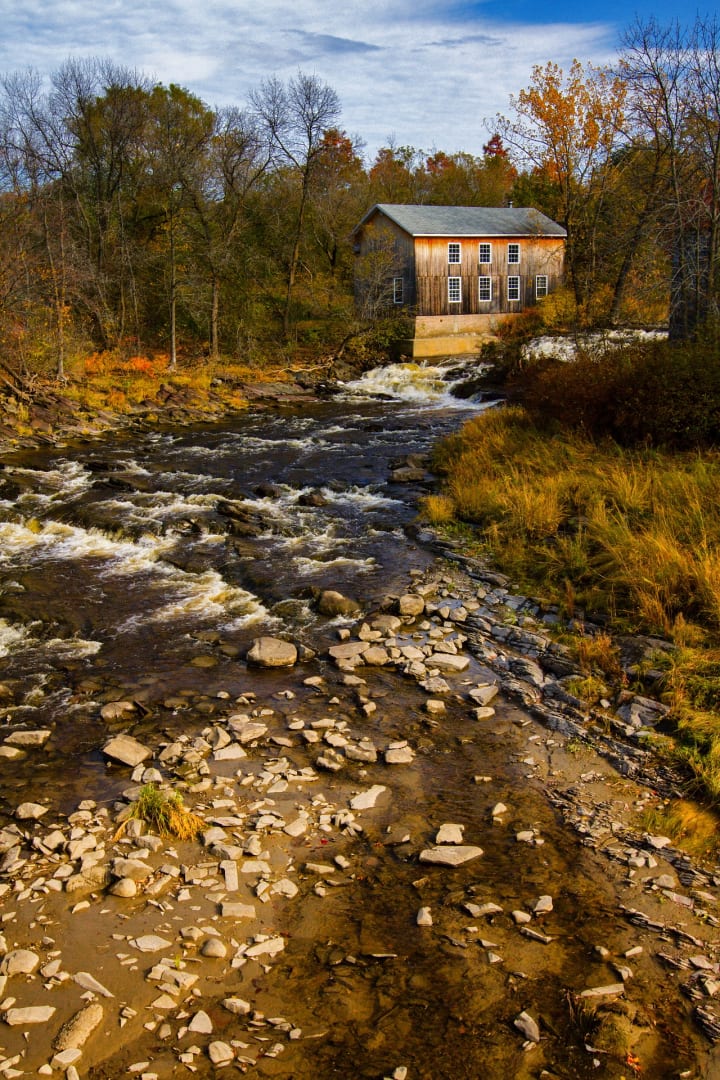5 Tips For Creating Fantasy Towns and Cities
Making The Fantastical Seem Believable

The fantasy genre often draws us in with promises of the strange, and the wondrous. From wizards' duels, to brooding dragons, to relics of ancient, bygone eras of glory, these stories offer us an escape from our reality. However, the fantastical elements of these tales are like the icing on a cake. They are where a great deal of the sweetness and enjoyment in consumption comes from, but these elements rely on the cake beneath to act as a foundation.
The cake, in this metaphor, is the rest of the setting.
Because no matter how bizarre, weird, or unusual the creatures, spells, or culture of a setting is, if you present it in a way that feels grounded to your audience, they'll be more than happy to swallow it. Not only that, but they'll probably ask for seconds!
If you want the cities and towns in your setting to have verisimilitude, then I'd recommend asking the following questions of your project, and seeing where they lead you!
And for those wondering about my bona fides, I'd recommend checking out my supplement 10 Fantasy Villages, as well as Ironfire: The City of Steel and one of its sister entries Moüd: The City of Bones for the Sundara: Dawn of a New Age setting.
Lastly, if you're looking for more world building and story advice, check out my author blog The Literary Mercenary, as well as my gaming blog Improved Initiative. And for more assorted geekery, consider taking a look at the rest of my Vocal archive while you're here!
Tip #1: What Resource Drew People Here?

Most settlements tend to be built around some kind of resource that residents want to live near because it makes their lives easier. Whether that's good growing soil for a farming community, veins of ore for a mining town, or lush, old growth forests for a lumber town. Generally this resource should accomplish at least one of two things:
1. Support the basic needs of the community (farm produce, fishing, etc.)
2. Create something of value that can be exported/exchanged (ore, lumber, etc.)
Given that these are fantasy settings, the resource in question can be as fantastical as you need it to be. It might be an unusual magical phenomenon, the rearing of a local monstrous species like hippogriffs or dragonsbreath salamanders (prominent working beasts, as well as a food animal, around Ironfire), or ironwood trees. It might also be a resources for an inhuman species, such as volcanic rivers for creatures that need the intense heat, or poisonous swamplands that are ideal homes for communities of trolls. However, the "resource" could also be a location. You see this with port cities, with towns built around the crossroads of major trade routes, or along rivers where a lot of travel comes downstream.
It's only once you know why a community sprang up there in the first place that you can extrapolate what comes next.
Tip #2: What Challenges Face This Community?

Often when we think of the challenges presented in fantasy settings we tend to focus on the big, flashy problems that can act as the basis for a story. Whether it's gangs of dangerous bandits in the woods, or aggressive ogres in the hills, we usually think of the sorts of problems that require adventurers to come and put a stop to them.
Challenges can come in all kinds of shapes and sizes, though. More importantly, these challenges shouldn't be things that can just be dealt with quickly; they should be a permanent (or at least long-term) part of a settlement's fabric in some way, shape or form.
For a mundane example, consider a town built on a river that has a rather notable flood season. When Winter transitions to Spring, the waters run fast, high, and wide, and that's just the way it is. Alternatively, the ironwood forest might be the domain of powerful fey, and a port city might find itself in pirate-infested waters due to the sheer value of the cargo that it draws from merchants looking to buy, sell, and trade.
The challenges can be as big or as small, as fantastical or as mundane as you want... but they should be there, because they give settlements a lot of character.
Tip #3: How Does The Town Deal With Said Challenge?

The challenges a town or city deals with should create some kind of permanent change structurally, culturally, or both. Especially if the challenge is not something that can be done away with, but rather has to be mitigated through some means.
Let's go back to the town that copes with seasonal floods.
If you want a simple way to deal with this problem, then you could simply have homes, taverns, etc. built on stilts. This is a simple way to ensure floodwaters pass by beneath, while allowing residents to stay high and dry. Alternatively, you could build communities on anchored rafts, allowing them to float atop the rushing waters. While less practical, it may present a more interesting, fantastical take on coping with the challenge. You could have a series of ditches built that allow for the waters to be bled off, rushing through the town, and perhaps spraying from the mouths of gargoyles in near-constant fountains for a week on end. The town might even stage its spring festivals around this time, with the gargoyles marking the return of the high waters, and the true end of winter.
Creative solutions to long-term issues can often change the fabric of a town in a meaningful way. For example, if a town has to deal with living cheek-by-jowl with the fey, are there odd rituals and strange rules to ensure safety and relative peace? Something like only walking on the right side of a road after dark, or leaving small offerings of butter and nuts on the doorstep? A town with a legitimately haunted forest might have shrines and wards along its roads and walls to ensure the dead stay out, and a town that's dealt with pirates or bandits may have a particularly well-trained militia, or the chapter house of a knightly order, built to push back against this issue.
Even if a challenge is dealt with in its entirety (the pirates moved on, the bandits dispersed, the orc raiders integrated into the community over a number of generations), the way that a town or city chose to meet a challenge should leave a permanent change in its traditions, look, and culture. Even if, over time, that change becomes more stylized (citizens wearing small dagger pendants instead of every member carrying swords, or archery becoming a sport or contest rather than a life-and-death means of civil service), it should be there to see for folks who know what they're looking for.
Tip #4: Is This Place Growing, or Dying?

Too often in fantasy settings we have a tendency to leave things static for huge periods of time. We have knights in shining armor with swords in the present, and we had knights in shining armor with swords a thousand years ago.
To make places feel lived-in, to make them feel really organic, it's important to introduce elements of change over time. Whether it's a village that's growing, on the cusp of becoming a proper city, or a city that's faded, losing what kept it vital, you need to know if this place is growing or shrinking, and why.
As an example, take the lumber camp initially established to cut ironwood trees. It starts out as a small operation, with cabins established to house workers, equipment, and the resources cut from the forest. A supply chain is established, with cooks, iron workers, and others coming into the camp, and lumber going out of it. The woodcutters have money to spend, which might draw peddlers, entertainers, gamblers, and more to come and set up shop.
The question that needs to be asked is will this lumber town grow, or will it dry up and blow away? For instance, is ironwood being harvested with an eye toward the long-term, with cutters taking from different parts of the forest and letting older areas regrow, ensuring the industry is sustainable? Does the town discover new resources, such as becoming a river port that draws commerce from surrounding areas, or perhaps finding hot springs that have supposedly curative effects (as you see in Timbersong, in 10 Fantasy Villages)? Are the cleared forests turned into farmland, or re-purposed for some other industry that proves equally profitable to logging?
Alternatively, consider a city that's begun its decline. Perhaps the black fleet of corsairs has bled the shipping lanes to the point merchants are no longer coming, starving it of commerce by the sea. Alternatively, a shipping canal may have been built many miles away, making travel to this city both more costly, and less profitable for those who once filled its port. Perhaps the swamplands have grown, collapsing the foundations of an entire quarter to the point where they can't be rebuilt, or the city found itself on the losing side of a conflict (a war of steel, or one of gold), and now it's wounded.
If a place is dying, that will transform what's happening there. You may see the trappings of once wealthy places falling into disarray, luxury goods may be offered at far lower prices so the owners can liquidate their wealth, and entirely new industries may crop up as a way to take advantage of the situation. Particular drugs once made illegal now simply come with a tax, for example, or magics once outlawed are now practiced openly by those who pay the fee to the governor.
Towns and cities alike should change, and those changes should lead to them shrinking or growing... but it's important to remember that if something is taking root (for good or ill), then you should look at who stood to gain from it, and why it's been allowed to continue.
Tip #5: Why Are People Still Here?

This isn't a question that always needs to be asked. If you have a prosperous city where people are taken care of, or a tight-knit community that sticks together, we understand why people are drawn to those places. There may be challenges to overcome, and dangers to face, but there's also good things about these places.
A lot of the time our fantasy cities run into what I've seen termed the Gotham problem.
Think of Batman's Gotham City during the classic, gothic period so many of us associate with the character. Gotham is a cesspool of corruption, where the mob runs the streets, the police force is unspeakably corrupt, and the city's elite feed off the sweat, tears, and misery of those beneath them. Add in the costumed criminals and their gangs of goons, and the city takes on an air of unspeakable danger and madness.
It's amazing for atmosphere... but it can sometimes make you question why the hell anyone would actually live there.
We often run into this same issue when it comes to particularly dark, bleak fantasy villages and cities. If the countryside is crawling with werewolves, or the city is ruled over by a magistocracy that sees the citizens as test subjects for their arcane experiments, or the royal family has an alliance with devils from the pits of the abyss... why are people still living here?
There are likely reasons... but you need to know what those reasons are.
For example, does the nation believe that being able to outwit devils and bind them to your service is a measure of personal power and cleverness, seeing this as a great virtue instead of as an extremely dangerous situation that puts everyone in peril? Do the fiends use their powers to do things that would have been considered impossible, acting as dread soldiers to create a powerful army, using their infernal powers to create an abundance of food and other resources, or simply providing their masters with secret information so they can always outwit their competition? Do the devils take their sacrifices in secret, allowing the public to write off the imagery and pageantry as mostly for show; something their rulers do to intimidate those who would stand against them?
Whether it's because the horror is kept under wraps, dealing with the dangers is seen as a sign of strength, the populace doesn't know any better (the darkness has been present for so many generations that it's just the way the world is to them), there isn't a viable alternative that feels like somewhere they could go, or they simply cannot leave for some reason (patrols keep a watch on the populous, those born on the cursed land are bound to it, the city is built on a walled island that's kept like a prison, etc.) make sure you have a reason why there are populations even in the worst places. Because if your readers start questioning it, you might find their suspension of disbelief beginning to buckle.
About the Creator
Neal Litherland
Neal Litherland is an author, freelance blogger, and RPG designer. A regular on the Chicago convention circuit, he works in a variety of genres.
Blog: Improved Initiative and The Literary Mercenary
Reader insights
Outstanding
Excellent work. Looking forward to reading more!
Top insights
Compelling and original writing
Creative use of language & vocab
Easy to read and follow
Well-structured & engaging content
Expert insights and opinions
Arguments were carefully researched and presented
Eye opening
Niche topic & fresh perspectives
Masterful proofreading
Zero grammar & spelling mistakes
On-point and relevant
Writing reflected the title & theme






Comments
There are no comments for this story
Be the first to respond and start the conversation.